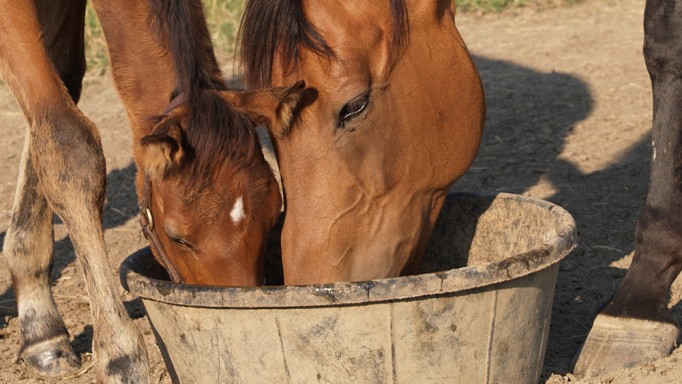Nutrients such as protein (and in particular key amino acids such as lysine), minerals (especially calcium, phosphorus, copper and zinc) and vitamins are extremely important when feeding the growing horse.
THE HEALTHY BROODMARE
Feeding for a healthy foal starts with feeding for a healthy broodmare, as the foal’s food source for the first few months of life will be milk produced by the mare. Of course, it is very important for the foal to receive colostrum, the mare’s first milk, shortly after birth, as it is high in antibodies that are needed for disease protection. Offering the mare a high-quality forage – either a straight legume such as alfalfa or a legume-grass mix such as alfalfa-timothy – and a commercially available concentrate formulated for broodmares will ensure she is meeting her nutrient needs for milk production. This type of diet will ensure the milk quality will be high; small deficiencies in any nutrients of the mare’s diet are rarely passed to the milk, as the mare will use her own stores as a sacrifice.
Horse owners should also ensure the mare is in a good body condition score (6-7 on the 1-9 Henneke scale) prior to foaling. Milk production is highly energetically demanding, and mares will often lose some weight while nursing. Having her in a slightly fleshy body condition score will allow her to lose some weight without getting thin, while also allowing her to be at a point where she is more reproductively efficient for the next breeding season.
FIRST SOLID FOOD
Eventually, you will notice your foal will become more and more interested in the mare’s feed. at this point you may consider offering your foal a ‘creep feed’ formulated for the growing foal. creep feed is usually offered such that a foal can consume the feed, but the mare cannot. creep feeding serves two very important purposes: 1) it provides nutrients to the foal when the quality and quantity of his dam’s milk production starts to decrease; and 2) it helps the foal become used to eating foods in preparation for weaning, which then decreases the stress of weaning. as well, high-quality forage should be offered to the foal – a legume-grass mix is ideal.
Once the foal is weaned, the concentrate will continue to play a major role in the foal’s nutrition, as he still won’t be eating as much forage as an adult horse (although the same legume-grass mix should be offered free choice). Offering a high-quality commercial feed formulated for growing horses is very important to ensure all of their protein, vitamin and mineral needs are being met. The amounts fed will depend on the forage offered (lower quality/higher grass forages may need more or even higherquality concentrates) and the foal itself.
MONITORING GROWTH RATE
It is very important to keep a keen eye on your foal’s growth rate during these early months of life. Developmental orthopedic diseases (DOD) are skeletal conditions that commonly arise in growing horses, and include conditions such as physitis and osteochondritis dissecans (OcD). DODs can be triggered by growth spurts and lags, nutritional deficiencies or toxicities, as well as genetics and trauma. Owners should monitor growth weight, ideally with an equine scale, which is the most accurate. You can purchase your own for about $1,000- $3,000, or most feed dealers will have a portable scale they can bring with them on consults. Simply measuring the horse’s height at the knee, withers and rump also works; by charting the growth over time, you can monitor for a nice slow growth curve. You can work with your veterinarian or equine nutritionist to determine how to adjust your foal’s diet based on this growth curve to minimize the risk of DOD.
The foal’s future potential as an athlete largely depends on their skeletal health, which is established mostly in that first year of life. Working closely with your equine nutritionist and veterinarian, and providing high-quality feed sources, will help ensure your foal grows into a healthy, mature horse.

